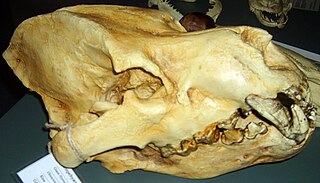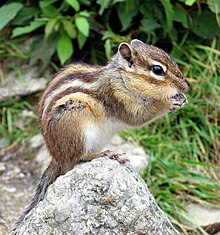
Chipmunks are small, striped rodents of Sciuridae, the squirrel family; specifically, they are ground squirrels (Marmotini). Chipmunks are found in North America, with the exception of the Siberian chipmunk which is found primarily in Asia.

A pika is a small, mountain-dwelling mammal native to Asia and North America. With short limbs, a very round body, an even coat of fur, and no external tail, they resemble their close relative, the rabbit, but with short, rounded ears. The large-eared pika of the Himalayas and nearby mountains lives at elevations of more than 6,000 m (20,000 ft).

Ground squirrels are rodents of the squirrel family (Sciuridae) that generally live on the ground or in burrows, rather than in trees like the tree squirrels. The term is most often used for the medium-sized ground squirrels, as the larger ones are more commonly known as marmots or prairie dogs, while the smaller and less bushy-tailed ground squirrels tend to be known as chipmunks.

Tamias is a genus of chipmunks in the tribe Marmotini of the squirrel family. The genus includes a single living species, the eastern chipmunk. The genus name Tamias means "treasurer", "steward", or "housekeeper", which is a reference to the animals' role in plant dispersal through their habit of collecting and storing food for winter use.

Eomyidae is a family of extinct rodents from North America and Eurasia related to modern day pocket gophers and kangaroo rats. They are known from the Middle Eocene to the Late Miocene in North America and from the Late Eocene to the Pleistocene in Eurasia. Eomyids were generally small, but occasionally large, and tended to be squirrel-like in form and habits. The family includes the earliest known gliding rodent, Eomys quercyi.

Asoriculus is an extinct genus of terrestrial shrews in the subfamily Soricinae and tribe Nectogalini, native to Europe and North Africa.

Percrocutidae is an extinct family of hyena-like feliform carnivores endemic to Asia, Africa, and Southern Europe from the Middle Miocene through the Pliocene, existing for about 8 million years.
Nestoritherium is an extinct genus of chalicothere; it has been dated to have lived from the late Miocene to the Early Pleistocene. This range makes Nestoritherium one of the most recently dated chalicotheres. It has been found in fossil sites in Myanmar and China.

Eucyon is an extinct genus of medium omnivorous coyote-like canid that first appeared in the Western United States during the late Middle Miocene 10 million years ago. It was the size of a jackal and weighed around 15kg. Its species E. zhoui was one of a number of North American mammals which invaded East Asia around 5–6 million years ago, followed by the genus going extinct 3 million years ago. This genus is proposed to have given rise to genus Canis 6 million years ago.

Ursavini is an extinct tribe of mammals of the family Ursidae (bears) endemic to North America, Europe, Africa, and Asia during Miocene through Pliocene, living from about 23—2.5 Mya, existing for roughly 20.5 million years.

Neotamias is a genus of chipmunks within the tribe Marmotini of the squirrel family. It contains 23 species, which mostly occur in western North America. Along with Eutamias, this genus is often considered a subgenus of Tamias.
This paleomammalogy list records new fossil mammal taxa that were described during the year 2012, as well as notes other significant paleomammalogy discoveries and events which occurred during that year.
This paleomammalogy list records new fossil mammal taxa that were described during the year 2013, as well as notes other significant paleomammalogy discoveries and events which occurred during that year.
This paleomammalogy list records new fossil mammal taxa that were described during the year 2014, as well as notes other significant paleomammalogy discoveries and events which occurred during that year.
This paleomammalogy list records new fossil mammal taxa that were described during the year 2011, as well as notes other significant paleomammalogy discoveries and events which occurred during that year.
This paleomammalogy list records new fossil mammal taxa that were described during the year 2010, as well as notes other significant paleomammalogy discoveries and events which occurred during that year.
This paleomammalogy list records new fossil mammal taxa that were described during the year 2016, as well as notes other significant paleomammalogy discoveries and events which occurred during that year.
Allacerops is an extinct genus of odd-toed ungulate belong to the rhinoceros-like family Eggysodontidae. It was a small, ground-dwelling browser, and fossils have been found in Oligocene deposits throughout Central and East Asia.
This paleomammalogy list records new fossil mammal taxa that were described during the year 2015, as well as notes other significant paleomammalogy discoveries and events which occurred during that year.
Merkurosaurus is an extinct genus of lizards from the Shinisauria that is known from the Late Oligocene of Germany, collected in 1999, and the Early Miocene Most Formation of the Czech Republic and the Wiesbaden Formation Germany of (Amöneburg). A single species, M. ornatus, is known and was named and described by Jozef Klembara in 2008 based on the holotype Pb 02045 and other referred specimens. It was initially only known from deposits in the Czech Republic but remains found in Germany were eventually attributed to the genus in 2015.










